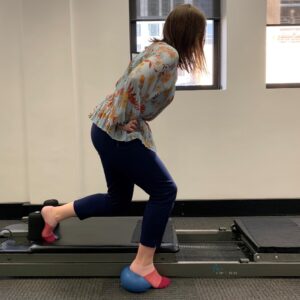Have you been trying to improve your running performance but just can’t seem to get there? Maybe you should try Pilates?
The ability to improve one’s running performance is based on a number of factors. It is thought that runners who have a high maximum consumption of oxygen and are able to sustain this over a long period of time along with the ability to move economically are seen to have the most efficient and effective running performance.1
But what does moving economically mean? Research suggests that to move economically means to be able to run the longest distance a person can, using the least amount of metabolic energy they can.1 It is known that this aspect of running performance can be improved through aerobic endurance training, strength training and plyometrics training.1 However emerging evidence also suggests that another aspect of moving economically is thought to be muscle activation, especially of the lower limb and trunk and that training specific muscle activation patterns can improve a runners economics and therefore performance.1
So how does Pilates help improve running performance?
Pilates is based on the principles of improving stability and control, along with correcting posture and breathing which is theorised to assist in improving muscle activation patterns and therefore improve running performance. A study published in 2018 set out to see if a 12 week Pilates training program would improve running performance in a group of 58 individuals over a 5km distance.1
The individuals were split into two groups with both groups receiving running training to improve their oxygen consumption over the 12 week period, with one of these groups also receiving specific Pilates training focusing on abdominal, trunk and lower limb strength, along with breathing and relaxation.1 The results were measured immediately after the 12 week period and it was found that the group that participated in Pilates had a statistically significant improvement in running performance over a 5km distance compared to those who just participated in running training alone.1 On average those who participated just in running training over the 12 week period improved their 5km time from 25.33 to 24.61 and those who participated in Pilates in combination with running training improved from 25.65 to 23.23 on average.1
Those who were in the Pilates group were also found to have used less energy to complete the run and improved running mechanics compared to those who were not in the Pilates group.1 So if you are trying to improve your running performance and just can’t seem to make it maybe it’s the time to add Pilates to your training routine.
In the next blog (Part 2) I will be showing you a few of my top Pilates exercises for improving running performance. In the meantime, if you can’t wait to start improving your running performance get in contact to see one of our fantastic Physios here in Sydney CBD for your Pilates assessment.
References:
- Finatto, P., Silva, E., Okamura, A. B., Almada, B. P., Storniolo, J., Oliveira, H. B., & Peyré-Tartaruga, L. A. (2018). Pilates training improves 5-km run performance by changing metabolic cost and muscle activity in trained runners. PloS one, 13(3), e0194057. https://doi.org/10.1371/journal.pone.0194057






